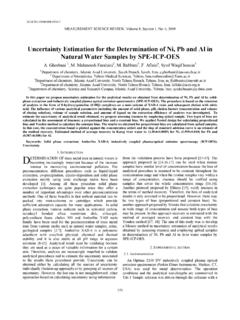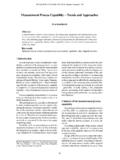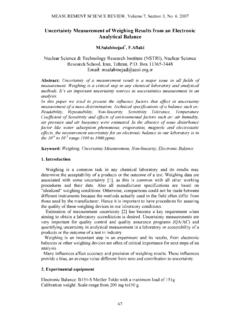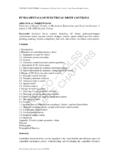Transcription of FUNDAMENTALS OF EEG MEASUREMENT
1 MEASUREMENT SCIENCE REVIEW, Volume 2, Section 2, 2002 FUNDAMENTALS OF EEG MEASUREMENT M. Teplan Institute of MEASUREMENT Science, Slovak Academy of Sciences, D bravsk cesta 9, 841 04 Bratislava, Slovakia Abstract: Electroencephalographic measurements are commonly used in medical and research areas. This review article presents an introduction into EEG MEASUREMENT . Its purpose is to help with orientation in EEG field and with building basic knowledge for performing EEG recordings. The article is divided into two parts.
2 In the first part, background of the subject, a brief historical overview, and some EEG related research areas are given. The second part explains EEG recording. Keywords: Electroencephalography, EEG, brain waves, EEG recording, EEG amplifiers 1. Introduction Modern medicine applies variety of imaging techniques of the human body. The group of electrobiological measurements comprises items as electrocardiography (ECG, heart), electromyography (EMG, muscular contractions), electroencephalography (EEG, brain), magnetoencephalography (MEG, brain), electrogastrography (EGG, stomach), electrooptigraphy (EOG, eye dipole field).
3 Imaging techniques based on different physical principles include computer tomography (CT), magnetic resonance imaging (MRI), functional MRI (fMRI), positron emission tomography (PET), and single photon emission computed tomography (SPECT). Electroencephalography is a medical imaging technique that reads scalp electrical activity generated by brain structures. The electroencephalogram (EEG) is defined as electrical activity of an alternating type recorded from the scalp surface after being picked up by metal electrodes and conductive media [1].
4 The EEG measured directly from the cortical surface is called electrocortiogram while when using depth probes it is called electrogram. In this article, we will refer only to EEG measured from the head surface. Thus electroencephalographic reading is a completely non-invasive procedure that can be applied repeatedly to patients, normal adults, and children with virtually no risk or limitation. When brain cells (neurons) are activated, local current flows are produced. EEG measures mostly the currents that flow during synaptic excitations of the dendrites of many pyramidal neurons in the cerebral cortex.
5 Differences of electrical potentials are caused by summed postsynaptic graded potentials from pyramidal cells that create electrical dipoles between soma (body of neuron) and apical dendrites (neural branches). Brain electrical current consists mostly of Na+, K+, Ca++, and Cl- ions that are pumped through channels in neuron membranes in the direction governed by membrane potential [2]. The detailed microscopic picture is more sophisticated, including different types of synapses involving variety of neurotransmitters.
6 Only large populations of active neurons can generate electrical activity recordable on the head surface. Between electrode and neuronal layers current penetrates through skin, skull and several other layers. Weak electrical signals detected by the scalp electrodes are massively amplified, and then displayed on paper or stored to computer memory [3]. Due to capability to reflect both the normal and abnormal electrical activity of the brain, EEG has been found to be a very powerful tool in the field of neurology and clinical neurophysiology.
7 The human brain electric activity starts around the 17-23 week of prenatal development. It is assumed that at birth the full number of neural cells is already developed, roughly 1011 neurons [4]. This makes an average density of 104 neurons per cubic mm. Neurons are mutually connected into neural nets through synapses. Adults have about 500 trillion ( ) synapses. The number of synapses per one neuron with age increases, however the number of neurons with age decreases, thus the total number of synapses decreases with age too.
8 From the anatomical point of view, the brain can be divided into three sections: cerebrum, cerebellum, and brain stem. The cerebrum consists of left and right hemisphere with highly convoluted surface layer called cerebral cortex. The cortex is a 1 MEASUREMENT in Biomedicine M. Teplan dominant part of the central nervous system. The cerebrum obtains centres for movement initiation, conscious awareness of sensation, complex analysis, and expression of emotions and behaviour.
9 The cerebellum coordinates voluntary movements of muscles and balance maintaining. The brain stem controls respiration, heart regulation, biorythms, neurohormone and hormone secretion, etc.[5]. The highest influence to EEG comes from electric activity of cerebral cortex due to its surface position. There are some theoretical and practical differences between EEG and MEG. Although the MEG is produced by the same electrical currents, it can provide complementary information to EEG [6]. 2. EEG: History, brain waves, applications History During more than 100 years of its history, encephalography has undergone massive progress.
10 The existence of electrical currents in the brain was discovered in 1875 by an English physician Richard Caton. Caton observed the EEG from the exposed brains of rabbits and monkeys. In 1924 Hans Berger, a German neurologist, used his ordinary radio equipment to amplify the brain's electrical activity measured on the human scalp. He announced that weak electric currents generated in the brain can be recorded without opening the skull, and depicted graphically on a strip of paper.

















